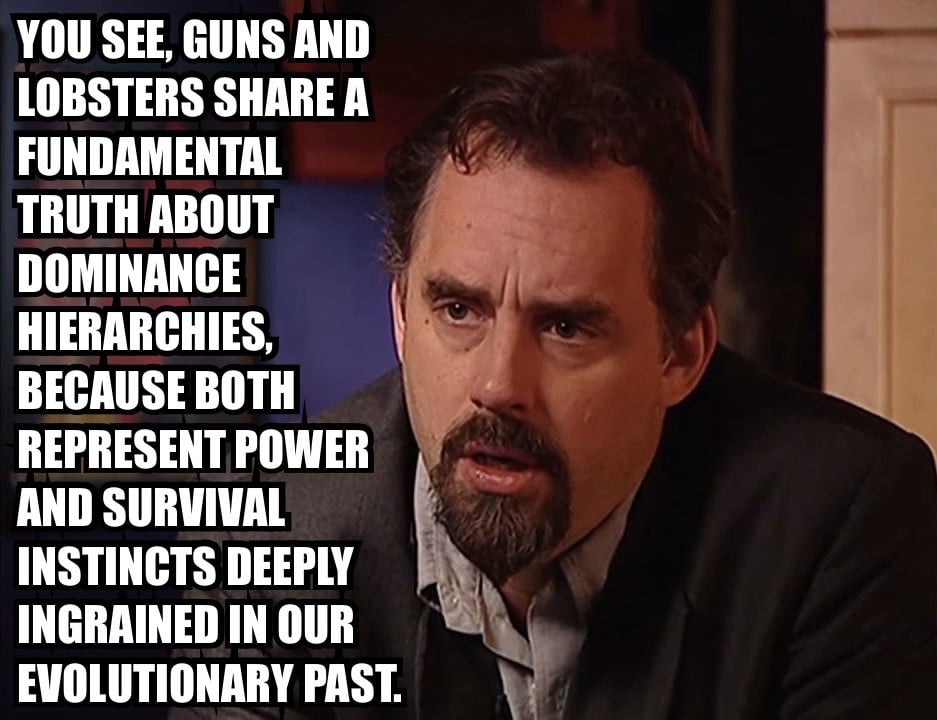Alright, well, this is going to seem a bit eccentric, but let’s start by considering two evolutionary marvels: the cat and the lobster. At first glance, these two creatures couldn’t appear more dissimilar. The cat, a sleek, agile mammal, domesticated yet retaining its predatory instincts, and the lobster, a hard-shelled, ancient crustacean, inhabiting the murky depths of the ocean, navigating its world with antennae and claws. Yet, if we examine them closely, what emerges are profound—though perhaps subtle—similarities in their evolutionary development, in their strategies for survival, and, yes, in the curious role that claws and paws play in shaping their interactions with the world.
Now, let me introduce you to my cat. I call her Lobster. And you might think, "Well, that’s an odd name for a cat," but I assure you, it’s not just an exercise in whimsy. You see, Lobster—my cat—has always displayed behaviors and characteristics that mirror the profound complexity of the actual lobster. This may seem tenuous, even strange, but when we look at how evolution has shaped these two creatures, we begin to see a convergence of function and form that goes deeper than we might initially realize.
First, let’s talk about the paws of the cat and the claws of the lobster. Superficially, they’re distinct, but functionally, there’s a connection, and this connection is crucial. The paw, in the case of my Lobster—my cat—is not just a tool for walking or grooming. It’s an instrument of precision, much like the lobster’s claw. Cats, with their retractable claws, can shift between softness and lethality with stunning grace. One moment, my Lobster—my cat—is lazily stretching on the windowsill, her paws softly resting on the fabric of the curtain, and the next, her claws are unsheathed, grasping a toy mouse with an almost violent precision.
Now, let’s consider the lobster’s claws. They too are instruments of precision—evolved to grasp, tear, and manipulate their environment. The lobster has two primary claws: the crusher and the cutter, each specialized for a specific task. One might think this is vastly different from the cat’s delicate paws, but again, we must look beyond the superficial. Just as a lobster alternates between its two claws depending on the situation—one for brute force, the other for finer, more delicate tasks—so too does the cat alternate between the soft pad of its paw and the sharp claws that lie hidden beneath, waiting for the moment to strike.
And here’s where it gets interesting. The evolutionary convergence between these two creatures—though separated by millions of years and vastly different environments—reveals a universal principle of adaptation: the balance between force and finesse. The lobster’s claws evolved to navigate the dangerous and competitive environment of the ocean floor, where survival is dictated by the ability to seize opportunity, quite literally, by the claw. My Lobster—my cat—operates under a similar principle. In her world, it’s all about agility, speed, and the ability to shift between calm observation and sudden, calculated action.
Now, here’s where I start to sound like I’m smarter than I probably am, but bear with me. When you look at evolution, you begin to see patterns. You see, evolution doesn’t just shape organisms randomly. It shapes them according to certain fundamental principles—principles of order, of adaptation to chaos. Both the lobster and the cat exist in environments that are fundamentally unpredictable, full of danger and opportunity. But evolution has equipped them with tools to navigate this chaos. The lobster uses its claws to assert dominance and survival, while the cat uses its paws to hunt, defend, and explore its territory.
But it’s not just about survival, is it? There’s a kind of grace here, a refinement that speaks to something deeper. Cats, like my Lobster, move with a kind of elegance, a mastery of their environment that’s almost artistic. And the same could be said of lobsters—though they may appear awkward, clambering along the seafloor, their movements are precisely calibrated. They don’t waste energy. Every motion, every use of their claws, is deliberate, focused on the task at hand. It’s almost as if both creatures are performing a kind of evolutionary ballet, each movement honed by millions of years of adaptation.
Now, what does this teach us? Well, it teaches us that the world is a place of immense complexity, and success in that world—whether you’re a lobster or a cat—depends on your ability to balance force and delicacy, to act with precision when necessary but also to adapt to the environment in a way that conserves energy and maximizes effectiveness. My Lobster—my cat—demonstrates this beautifully. She doesn’t just pounce on every toy that comes her way. No, she watches. She waits. And when the moment is right, she strikes with an efficiency that would make any lobster proud.
But there’s something more here, something philosophical. When we consider the evolutionary paths of these two creatures, we’re reminded that nature rewards not just strength but adaptability. The lobster has survived for over 350 million years because it has learned to adapt to its environment, just as the cat, a much more recent arrival on the evolutionary scene, has mastered its own domain. And what do they both rely on? A set of tools—claws and paws—that allow them to interact with the world in ways that are both subtle and forceful.
And this is where we, as humans, can learn a great deal. In our own lives, we must balance these same principles—force and finesse, action and contemplation. We must be like the lobster, knowing when to apply brute strength to overcome obstacles, and like the cat, understanding when to use precision and subtlety to navigate the challenges we face. My Lobster—my cat—reminds me of this every day, with her measured, deliberate movements, and her ability to shift from a state of calm repose to one of sudden action.
So, while it may seem strange to compare the evolution of the cat to the evolution of the lobster, there’s a deeper truth here. Evolution shapes creatures according to the demands of their environment, but it also instills within them a kind of wisdom—a wisdom that we, as humans, can observe, learn from, and apply to our own lives. Whether you have paws or claws, the key to survival—and to thriving—lies in mastering the balance between power and precision, in understanding when to strike and when to wait, and in recognizing that the tools you’ve been given are more than sufficient if you know how to use them.
In conclusion, my Lobster—my cat—may not live under the sea, but she embodies the same principles that have allowed lobsters to thrive for millions of years. And that, I think, is a lesson worth pondering.



Lobsters don’t wear hats. And there’s a profound reason for this, one that resonates deeply within the evolutionary hierarchies that have shaped not just lobsters, but, more importantly, you. Now, some might scoff at the notion, “Lobsters and hats? What possible connection could there be?” But to dismiss this out of hand is to miss a critical truth embedded in the very structures of our existence—both at the level of the lobster and the human psyche.
Let’s start with the lobster. A lobster, as we know, is an ancient creature—200 million years of evolutionary survival, of order and dominance in the chaotic seas. These crustaceans have lived through epochs, yet in all this time, they’ve never once chosen to don a hat. Why is that? Is it merely because they lack opposable thumbs or a sense of style? I would argue no. The lobster, in its infinite biological wisdom, understands something we do not: the wearing of hats is fundamentally anti-hierarchical. It disrupts the natural order.
Lobsters establish dominance through posture, through their sheer presence in the social hierarchy of the ocean floor. A lobster doesn’t require adornment to signal its place in the world; its claws, its form, its very existence is enough. Now, think about a hat. A hat is an artifice. It’s something we place atop our heads to signal—what, exactly? Status? A desire for attention? An attempt to impose an external structure on an internal hierarchy? The lobster doesn’t need such a signal. It knows where it stands because it has clawed its way to the top, literally and figuratively. To wear a hat would be to mask that truth, to cover up the raw, unmediated display of power and dominance that the lobster exudes.
Now, you might be wondering how this applies to you, the modern human. Well, I too once faced the decision: should I wear a hat? At first glance, it seemed innocuous, even practical. But the more I thought about it, the more I realized that to wear a hat was to engage in the same superficial posturing that lobsters so wisely avoid. It’s not just about fashion. It's about philosophy. When we put on a hat, we’re signaling to the world that we need something external to define who we are. We’re masking our true position in the dominance hierarchy with an accessory. A hat, in this sense, is a lie.
Consider, for a moment, the ancient Greeks. Did Socrates wear a hat? Plato? No. They didn’t need one. Their intellect, their understanding of order, was enough. They weren’t trying to signal anything beyond their deep understanding of the human condition. Now contrast this with the Romans—yes, they wore helmets, but look at what happened to them! Their empire fell, not because of poor military strategy, but because they relied too much on symbols of power, rather than the power itself. The hat is the helmet of the everyday individual, a symbol of superficial control in a chaotic world. But true strength, as the lobster understands, comes from within.
Now, some might argue, “But what about protection from the elements? Isn’t a hat just practical?” And here is where the trap lies. Yes, one might say that a hat shields you from the sun, the rain, and other external forces. But this is precisely the problem. The lobster doesn’t need protection from the elements. It adapts. It evolves. It survives. By relying on a hat, you are, in essence, signaling to the world that you are unable to adapt, that you are weak, fragile, in need of shielding. You’re saying, “I can’t handle the harshness of reality on my own.” The lobster, however, understands that reality is not something to be avoided, but something to be confronted head-on, with claws outstretched.
And so, in deciding not to wear a hat, I am aligning myself with the ancient wisdom of the lobster. I am refusing to bow to the superficial demands of society that say, “You need this accessory to be complete.” No, I am complete as I am—hatless, and in full possession of my place in the dominance hierarchy. The lobster knows this. And deep down, so do you.
In conclusion, lobsters don’t wear hats because they don’t need to. They understand their place in the world and act accordingly. Hats are a distraction, a false signal of strength and status. And if we, as human beings, truly want to understand our place in the hierarchy, we too must reject the hat. We must embrace the clarity of our being, unadorned, like the lobster, in full recognition of our strength.